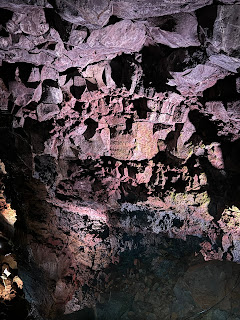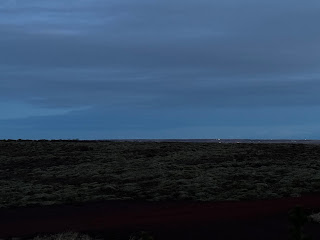Friday, April 12th:
We were able to sleep in this morning and do some laundry before heading out.
But first we started with another delicious breakfast from Joyce: fruit, skyr, granola, fresh salmon, avocados, tomatoes, cucumbers, turkey, and cheese. Gotta start the day off right!
Joyce had planned on taking us to the Þingvellir National Park, but it's better when it's sunny outside. So, she decided to save that for tomorrow. Josh had mentioned that he wanted to see a lava cave. Since it was cloudy with a chance of rain today Joyce moved our plans around and we booked tickets to go into a lava tunnel!
After a late breakfast we headed out to Raufarhólshellir (The Lava Tunnel).
Before the tour started our guide gave us a safety briefing and told us to grab a hard hat. She told us that crampons were optional, but it was icy in the cave so she highly recommended them.
[Crampons on - I don't need to slip and fall]
[Ready to explore the cave]
As we headed inside our guide told us about the cave and some of the things we would see. I've been in lava caves before at
Craters of the Moon, so I thought I knew what I was in for, but I was wrong!
This lava tunnel formed about 5000 years ago after the eruption of the Leitin shield volcano. As the lava flows from the volcano it creates a river. That river is hot and cuts into the ground. Eventually the top layer will cool (forming a blanket) while the lava continues to flow in the river. Eventually the lava will flow out and leave behind a tube. This particular tube is 4500 ft long and is up to 30 feet tall and 100 feet wide. Prior to 2016 the cave was free to visit and there were no guided tours. But this lead to vandalism and tons (literally) of trash being left behind. The land owners closed the cave until they were approached by a group of people who wanted to clean up the cave and take care of it properly. It took two years, but they were able to remove seven TONS of trash, clean the cave, and put in stairs and rails. Now the cave can only be accessed by taking a tour with a guide.
[Entrance]
As we walked into the cave we saw these huge mounds of snow. There are three natural openings in the ceiling where the blanket collapsed. These openings allow light and snow to come in. Our guide asked us what we would call these openings. I said a "skylight" and she said that Icelanders are VERY literal and they call them "holes in the ground." 🙂
Our guide told us that we needed to be nice to the "babies" that are forming in the next chamber. She asked us not to touch or kick them. Why would I kick a baby?!
We entered the next chamber and saw what she was talking about!
Look at these ice babies! She then told us that the Icelanders call them "upside down icicles." Yep, very literal.
Stalactites grow down from the cave ceiling, while stalagmites grow up from the cave floor. When the two meet, do you know what they call 'em? Call 'em? Column. Get it? Nerd.
[Ice column]
Aren't they so cute?!
In limestone caves, like the ones in the US, the rain seeps through the rocks and breaks down the stone. When the water drops drips from the ceiling to the floor it takes a tiny piece of sediment with it. This is what eventually forms stalagmites and stalactites. In lava caves this doesn't happen. Lava is very hard and porus, so when the water drops down it does NOT take sediment with it. But if it's cold it will form these cool upside down icicles!
Our tour guide then had us gather on this large platform where she told us more about the cave.
NASA was very interested in this particular cave because of the cave bacteria that was found here. It feeds and grows on iron deposits and does not need oxygen to survive. NASA came to this cave and took samples. They think this bacteria may be similar to life they could find on Mars. AND, fun fact, the bacteria was found by an Icelander and he named it... can you guess? "Cave bacteria" 🙂

Our guide pointed out all the different colors on the rocks. The yellow is sulfur, the red is iron, and the white speckles is the cave bacteria.
She then pointed out this wall. This is the only original wall that is left in the cave. The striations are caused by the lava when it was flowing through the cave.
And if you look closely you can see tiny stalactites. These original walls are fragile and tend to crumble off over the years. She then pointed her light at the ceiling and showed us the only three remaining lava straws in the entire cave. They are very fragile and all the others were broken off and taken by vandals.
To end the tour our guide asked us if it was okay if she turned off all the lights. We turned off our helmet lights and she hit the power button. It was so dark, like soooo dark. It was actually very disorientating. We stood in the darkness until a child started crying and then she asked us to turn our headlights back on.
Our guide told us that our tour was over and we could take our time climbing back out (just don't knock over the babies). She said that they have another tour that takes four hours. It continues from the platform we were on and goes all the way to the end of the tunnel. BUT there are no lights, no paths, and no stairs. Now, that would be quite an adventure!
We made our way slowly back to the start of the cave.
[Josh with the upside down icicles]
Have you seen the Alien movies? They kinda look like the egg pods.
["Holes in the ground" aka skylights]
[Moss]
What a cool experience! I was surprised when I saw the cost of the tickets for an hour long tour, but I am so glad we went. It was 100% worth it to see the ice babies! If you go in the winter or summer you won't see them. The weather needs to be just right in order for them to form!
After exploring the cave we headed to the Seltún Geothermal Area. As we were driving a spotted a lighthouse and asked Joyce if we could go check it out. She said "Of course!"
As we were heading towards the light house we saw these handsome guys.
He was ready for a photo shoot!
After some intense off-roading we made it to the Selvogsviti Lighthouse. In 1919 a lighthouse was built here, but it rusted out and had to be rebuild out of concrete in 1931.
It wasn't too windy so we walked down to the water.
[Beautiful!]
After visiting the lighthouse we drove along the coast towards Grindavik.
The roads around Grindavik are closed due to the volcano, but Grindavik was not our destination, so we turned off 427 and headed north on 42.
We briefly stopped by the Krýsuvík church. According to the sign the church "was built in 1857. It is a typical Icelandic country church from the 19th century. It was discontinued as a parish church in 1929 and for a time used as a living quarters. In earlier times this was the site of a large and prosperous estate with numerous dependencies. The farm was abandoned around 1950. Restored in 1964, the church is now under the protection of the National Museum. The church burned down on 2 January 2010. It was rebuilt and erected in its original form in 2020."
[Gigvatnsvatn - "Green Lake"]
We then arrived at the Seltún Geothermal Area. After walking through a super stinky cloud we were able to explore the area from the safety of a wooden boardwalk.
The area has fumaroles, mudpots, hot springs, and warm springs.
The yellow soil is caused by sulfur while the red is iron.
These geothermal areas are stinky, but they remind me of Yellowstone, and I love Yellowstone!
The wind was still quiet, so on our way back to the cottage we stopped by the same black sand beach (by Eyrarbakki) that we went to our second day here.
[I can't get enough of these views]
That night Joyce prepared us a delicious dinner of lamb, beans, and mashed potatoes. She thought it was crazy that people from the US don't eat a lot of lamb, so she wanted to prepare a nice home cooked meal for us. She put the lamb in a large pot with butter and garnish for a few hours. By the time dinner was served it was very tender and juicy. Hats off to the chef! Thanks Joyce!
[Beautiful sunset from the cottage]
[Blue Hour]
Where we went today:




























































































No comments:
Post a Comment